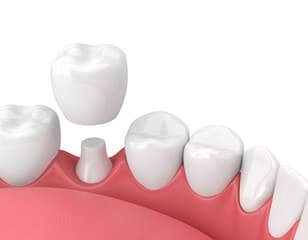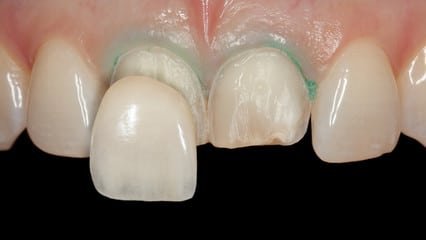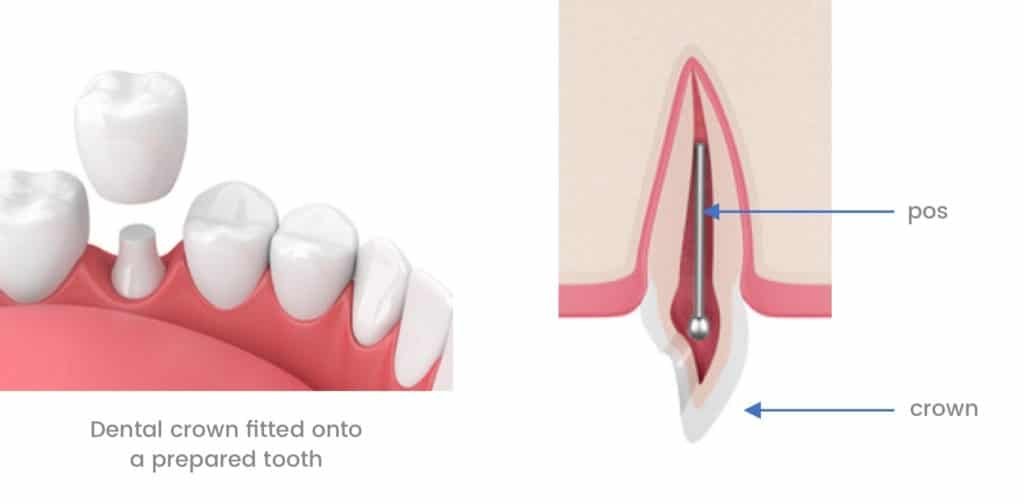
Prosthodontics is the area of dentistry concerned with rebuilding or replacing teeth. A part of a tooth can be damaged by decay, or break away by being knocked, or wear down. This damaged section can then be repaired with composite, veneers or crowns. Teeth can be lost due to many reasons such as decay, gum disease, abscesses, or trauma. The lost tooth or teeth can then be replaced with bridges, dentures, or dental implants. At Steve Bassi Dental we will discuss the best option in your particular case, taking into account a variety of factors including your wishes.
Dental composite is a synthetic material that is bonded onto a tooth to repair a chipped or broken area, or to improve the look of a tooth that has worn down. Composite can also be used to improve the shape of a tooth or to close gaps between teeth. It can be an excellent technique to improve the appearance of a tooth without the need to cut more of the tooth down as is the case for a veneer or a crown. Often building up teeth with composite can be done without the need for dental injections or using the high speed dental drill. An outstanding aesthetic result can be achieved to restore the cosmetics of your teeth as the composite material comes in a variety of colours. This allows a close match to the existing colour of your teeth or the composite technique can be used to make the teeth whiter. This is useful if a number of discoloured teeth need building up. Meticulous attention to detail is required to ensure the composite material bonds to your tooth correctly. When using composite in this way, the tooth is built up by your dentist and so the result is immediate. An example of using composite to close the gap between teeth is shown below.

Dental veneers are thin coverings that are bonded onto the surface of a tooth. Most people think of veneers as a way of improving the appearance of a tooth. In these situations the veneer is usually made out of porcelain in a dental laboratory and then glued onto the visible part of the tooth. However, the veneer technique can also be very useful to build up the inner (palate) aspect of the upper front teeth when they have worn down. This is often done by specialists in prosthodontics to increase the level of the bite and provide better biting support for the dentition. In these cases, the veneer can be made from porcelain, composite or metal as it is not on a visible part of the tooth. The composite technique for these veneers is different to the composite described above because the thin composite veneer is made in a dental laboratory and bonded in place at a subsequent appointment.
The traditional use of porcelain veneers on the visible parts of a tooth involves removing some healthy tooth structure to make room for the veneer material. Although only a small amount of tooth structure is removed, normally 0.5mm – 1.0mm, it still does irreversibly damage the tooth. Therefore, at Steve Bassi Dental we will carefully assess whether this is the most appropriate option for you as often the composite technique is a more conservative solution. However, veneers do have a role to play, for example if an existing porcelain veneer needs to be replaced, or if composite materials have failed in the past.

A dental crown is a type of restoration that completely covers a tooth. It is also known as a cap. The purpose of a crown is usually to protect the underlying tooth structure which has significantly broken down. Crowns are also commonly used on back teeth after root canal treatment to improve the chance of the tooth lasting longer, or in teeth that have cracked. Dental crowns can be made from porcelain, metal, or metal and porcelain fused together and if performed correctly, can be expected to last for years. One of the disadvantages of crowns is that the tooth has to be prepared by reshaping it in a particular way to receive the crown. This can remove quite a lot of healthy tooth structure and therefore it is important crowns are only used where absolutely necessary. Once the tooth has been prepared an impression or mould is taken of the teeth to allow the dental technician to fabricate the crown. The crown is then glued in place at a subsequent appointment, but in between appointments your dentist will make a temporary crown that is fitted onto the tooth.
In root-filled teeth it is sometimes necessary to insert a post or peg into the root canal of a tooth to help keep a crown in place. This is usually the case in very broken down teeth. The post is glued into the tooth and then the crown is cemented in place on top. This combination is called a post-crown.

When a tooth is missing, the adjacent tooth or teeth can be used to support a bridge. A bridge is termed a ‘fixed’ solution i.e it is designed to be glued in place and is not removable by you. A traditional bridge involves reshaping either or both teeth adjacent to the gap in a very similar way to crowns, and a mould is taken which is sent to a dental technician who fabricates the bridge. The bridge is made up of the ‘crown part’ that fits onto the anchor teeth, and the fake tooth section which replaces the missing tooth or teeth. The whole structure is made in one piece by the technician and is glued in place by the dentist. This type of bridge has been used for many years but does mean quite a lot of the tooth structure on the anchor teeth needs to be removed. Therefore, the traditional type of bridge is often only recommended when the potential anchor teeth would benefit from being covered with crowns. At Steve Bassi Dental we will discuss with you if this type of bridge is appropriate in your mouth.
An alternative type of bridge is called an adhesive bridge or a resin bonded or resin retained bridge. This type of bridge utilises modern gluing techniques and has been shown to be very effective in particular situations. The biggest advantage of adhesive bridges is that the anchor tooth/teeth do not need to be prepared in the way that is required for traditional bridges. Often the anchor teeth do not have to be touched at all or at the most only minimal preparation of approximately 0.5mm is required. Therefore, there is no need to numb the teeth up and any dental drilling is kept to a minimum. If your teeth do not have fillings then usually the adhesive type of bridge is much more preferable than the traditional type.

Unlike bridges, dentures are false teeth that are designed to be removed by you on a daily basis. Dentures can replace any number of teeth from just one tooth or all of your teeth. A complete denture is one that replaces all of the teeth in a jaw whereas a partial denture replaces only some of your teeth. In addition to replacing teeth, dentures can artificially replace any lost gum tissue. Dentures can be made from a hard resin called acrylic or can be made from a metal alloy with acrylic added on top. The metal alloy adds strength to the structure and also allows the dentures to be thinner and more intricate. Dentures can be very useful when quite a lot of teeth are being replaced. The process of making good quality dentures involves many steps and a close working relationship between your dentist and the technician. Partial dentures require detailed analysis of your teeth so that the optimum design of the denture is produced. Small modifications to some of the teeth can make the partial denture much more stable. If you have not worn dentures before, it can take a period of time to get used to them. This is completely normal and the vast majority of people find they become accustomed to the dentures, and the increased confidence when smiling and eating greatly improves their quality of life. However some patients find dentures too cumbersome, or the dentures cannot be made stable due to shrinkage of the underlying gum structure. In these situations, dental implant treatment can be considered.

Dental implants are another way of replacing missing teeth. Please see our dental implant section for more information on this particular type of treatment.